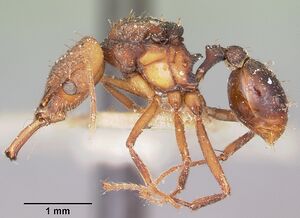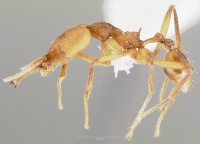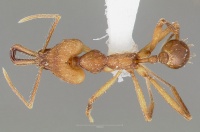Strumigenys grandidieri
| Strumigenys grandidieri | |
|---|---|

| |
| Scientific classification | |
| Kingdom: | Animalia |
| Phylum: | Arthropoda |
| Class: | Insecta |
| Order: | Hymenoptera |
| Family: | Formicidae |
| Subfamily: | Myrmicinae |
| Tribe: | Attini |
| Genus: | Strumigenys |
| Species: | S. grandidieri |
| Binomial name | |
| Strumigenys grandidieri Forel, 1892 | |
This is a well collected species and is known from a range of forest habitats. It has been found in rotten wood, from dead sticks to rotting logs, and collected via a number of passive sampling methods (pitfall, litter, etc.).
Identification
Bolton (2000) - The only member of the grandidieri complex in the Strumigenys grandidieri-group. In this group grandidieri is the only species with truncated preapical mandibular teeth. Its large size and lack of a pronotal humeral hair also help identify the species.
Keys including this Species
Distribution
Latitudinal Distribution Pattern
Latitudinal Range: -18.78472222° to -18.78472222°.
| North Temperate |
North Subtropical |
Tropical | South Subtropical |
South Temperate |
- Source: AntMaps
Distribution based on Regional Taxon Lists
Malagasy Region: Madagascar (type locality).
Distribution based on AntMaps
Distribution based on AntWeb specimens
Check data from AntWeb
Countries Occupied
| Number of countries occupied by this species based on AntWiki Regional Taxon Lists. In general, fewer countries occupied indicates a narrower range, while more countries indicates a more widespread species. |

|
Estimated Abundance
| Relative abundance based on number of AntMaps records per species (this species within the purple bar). Fewer records (to the left) indicates a less abundant/encountered species while more records (to the right) indicates more abundant/encountered species. |

|
Biology
Castes
Worker
Images from AntWeb
   
| |
| Syntype of Strumigenys grandidieri. Worker. Specimen code casent0101253. Photographer April Nobile, uploaded by California Academy of Sciences. | Owned by MHNG, Geneva, Switzerland. |
   
| |
| Syntype of Strumigenys grandidieri. Worker. Specimen code casent0101254. Photographer April Nobile, uploaded by California Academy of Sciences. | Owned by MHNG, Geneva, Switzerland. |
Queen
Images from AntWeb
   
| |
| Syntype of Strumigenys grandidieri. Queen (alate/dealate). Specimen code casent0101563. Photographer April Nobile, uploaded by California Academy of Sciences. | Owned by MHNG, Geneva, Switzerland. |
Nomenclature
The following information is derived from Barry Bolton's Online Catalogue of the Ants of the World.
- grandidieri. Strumigenys grandidieri Forel, 1892k: 517 (w.) MADAGASCAR. See also: Brown, 1954k: 12; Fisher, in Bolton, 2000: 654.
Unless otherwise noted the text for the remainder of this section is reported from the publication that includes the original description.
Description
Worker
Fisher (2000) - TL 4.8-5.8, HL 1.25-1.45, HW 0.97-1.14, CI 76-80, ML 0.67-0.76, MI 52-57, SL 0.87-1.03, SI 89-93, PW 0.52-0.57, AL 1.26-1.49 (9 measured).
Characters of grandidieri-complex. Mandibles almost straight and at full closure parallel. Apical fork of mandible with 2 spiniform teeth, without intercalary teeth or denticles. Mandible with 2 preapical teeth of similar size, short and truncated, situated in the apical third of the length; proximal preapical tooth occasionally reduced on left mandible. Upper scrobe margin ends, or at least becomes extremely indistinct, at about the level of the eye. Eye large, convex, and plainly visible in full-face view. Scape slender and subcylindrical, more or less straight, the leading edge with a row of fine hairs which are slightly flattened or spoon-shaped apically. Cephalic dorsum with curved narrowly spatulate ground-pilosity; hairs on upper scrobe margin are the same shape and size as those on the dorsum. Cephalic dorsum with 6 simple standing hairs arranged in a transverse row close to the occipital margin and a more anteriorly situated pair on vertex. Dorsum of head reticulate-punctate with superimposed rugulation. Pronotal humeri rounded, humeral hair absent. Anterior margin of mesonotum with a pair of stout filiform hairs. Ground-pilosity on alitrunk as on head but sparser. Dorsum of alitrunk in outline convex anteriorly, posterior mesonotum forming a long slope down to the metanotal groove, propodeal dorsum more or less flat. Anterior mesonotu m with a distinct narrow carina above the mesothoracic spiracle. Propodeal spines narrowly triangular and almost spiniform, divergent; propodeal lamella absent. Alitrunk dorsum and sides densely reticulate-punctate, central katepisternum occasionally smooth and shiny. Fine rugulose sculpture present on alitrunk dorsum, most distinct on anterior pronotal margin. Petiole node in dorsal view reticulate-punctate and slightly longer than broad. Postpetiole disc reticulate-punctate. Spongiform appendages of petiole and postpetiole extremely reduced, spongiform collar present on disc of postpetiole. Basigastral costulae short and distinct, remainder of gaster smooth and shiny when clean. Petiole dorsum without standing hairs. Dorsum of postpetiole with one pair of posterior projecting hairs. Dorsal surface of gaster with stout standing hairs. Colour yellowish brown to medium brown.
Type Material
Fisher (2000) - Syntype worker, MADAGASCAR: Foret d 'Andrangoloaka (Sikora) (Museum of Comparative Zoology) [examined].
References
- Borysenko, L.H. 2022. The male of the ant genus Rhopalothrix (Hymenoptera: Formicidae: Myrmicinae). Neotropical Entomology 51, 413–422 (doi:10.1007/s13744-022-00947-w).
- Brown, W. L., Jr. 1954k. The ant genus Strumigenys Fred. Smith in the Ethiopian and Malagasy regions. Bulletin of the Museum of Comparative Zoology 112: 1-34 (page 12, redescription of worker)
- Fisher, B. L. 1997a. Biogeography and ecology of the ant fauna of Madagascar (Hymenoptera: Formicidae). J. Nat. Hist. 31: 269-302 (catalogue)
- Fisher, B.L. 2000. The Malagasy fauna of Strumigenys. Pp. 612-696 in: Bolton, B. 2000. The ant tribe Dacetini. Memoirs of the American Entomological Institute. 65:1-1028.
- Forel, A. 1892l. Nouvelles espèces de Formicides de Madagascar (récoltées par M. Sikora). Première série. Ann. Soc. Entomol. Belg. 36: 516-535 (page 517, worker described)
- Wheeler, W. M. 1922k. Ants of the American Museum Congo expedition. A contribution to the myrmecology of Africa. IX. A synonymic list of the ants of the Malagasy region. Bull. Am. Mus. Nat. Hist. 4 45: 1005-1055 (page 1034, catalogue)
References based on Global Ant Biodiversity Informatics
- Blaimer B. B., S. G. Brady, T. R. Schultz, and B. L. Fisher. 2015. Fucntional and phylogenetic approaches reveal the evolution of diversity in a hyper diverse biota. Ecography 38: 001-012.
- Bolton, B. 2000. The Ant Tribe Dacetini. Memoirs of the American Entomological Institute 65
- Fisher B. L. 1997. Biogeography and ecology of the ant fauna of Madagascar (Hymenoptera: Formicidae). Journal of Natural History 31: 269-302.
- Fisher B. L. 1999. Ant diversity patterns along an elevational gradient in the Réserve Naturelle Intégrale d'Andohahela, Madagascar. Fieldiana Zoology (n.s.)94: 129-147
- Fisher B. L. 2003. Formicidae, ants. Pp. 811-819 in: Goodman, S. M.; Benstead, J. P. (eds.) 2003. The natural history of Madagascar. Chicago: University of Chicago Press, xxi + 1709 pp.
- Ratsirarson H. J., and B. L. Fisher. 2005. Ant (Formicidae) diversity in the Mantadia-Zahamena corridor, Madagascar. Schmid, J. et L.E. Alonso (eds). 2005. Une évaluation biologique rapide du corridor Mantadia-Zahamena à Madagascar. Bulletin RAP dEvaluation Rapide 32. Conservation International. Washington, DC.
- Santschi F. 1913. Clé analytique des fourmis africaines du genre Strumigenys Sm. (Hym.). Bulletin de la Société Entomologique de France 1913: 257-259.

